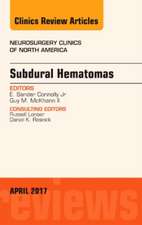Trepanation, Trephining and Craniotomy: History and Stories
Autor José M González-Darderen Limba Engleză Hardback – 7 oct 2019
To complement the general overview and offer readers a more ‘hands-on’ sense of context and atmosphere, extensive historical references, stories, media news and illustrative cases have been included for each historical and geographical scenario. In addition, original illustrations and plates of these archaic instruments and techniques are supplied.
Neurosurgical surgeons, nurses, technicians, medical historiographers, paleo-pathologists and researchers interested in surgical techniques for cranial opening will find the volume a valuable guide, intended to increase the historical and cultural awareness of this core topic in neurological surgery.
| Toate formatele și edițiile | Preț | Express |
|---|---|---|
| Paperback (1) | 582.65 lei 38-44 zile | |
| Springer International Publishing – 7 oct 2020 | 582.65 lei 38-44 zile | |
| Hardback (1) | 702.16 lei 38-44 zile | |
| Springer International Publishing – 7 oct 2019 | 702.16 lei 38-44 zile |
Preț: 702.16 lei
Preț vechi: 739.12 lei
-5% Nou
Puncte Express: 1053
Preț estimativ în valută:
134.37€ • 139.44$ • 112.31£
134.37€ • 139.44$ • 112.31£
Carte tipărită la comandă
Livrare economică 11-17 martie
Preluare comenzi: 021 569.72.76
Specificații
ISBN-13: 9783030222116
ISBN-10: 303022211X
Pagini: 462
Ilustrații: XII, 436 p. 160 illus., 41 illus. in color.
Dimensiuni: 178 x 254 mm
Ediția:1st ed. 2019
Editura: Springer International Publishing
Colecția Springer
Locul publicării:Cham, Switzerland
ISBN-10: 303022211X
Pagini: 462
Ilustrații: XII, 436 p. 160 illus., 41 illus. in color.
Dimensiuni: 178 x 254 mm
Ediția:1st ed. 2019
Editura: Springer International Publishing
Colecția Springer
Locul publicării:Cham, Switzerland
Cuprins
PART I INTRODUCTION. TREPAN, TREPHINE AND CRANIOTOMY.- 1 An overview.- 2 Semantic features.- PART II. MAGIC TIMES. TREPANATION IN PRIMITIVE CULTURES.- 3 Facts and myths of primitive trepanations.- 4 Techniques and tools for primitive trepanations.- 5 The question of survival.- 6 Historical and geographical areas.- PART III. ORIGINS. TREPANATION IN CLASSICAL MEDITERRANEAN CULTURES.- 7 The first documented report of the surgical trepanation appears in the Corpus Hippocraticum.- 8 Greco-Roman surgical instruments for trepanation.- 9 Greco-Roman technique of trepanation.- 10 Greco-Roman indications for trepanation.- PART IV. DARK TIMES. TREPANATION IN THE MIDDLE AGES. 11 Trepanation in the medieval Islamic and Christian cultures.- PART V. LIGHTS AND SHADOWS. TREPANATION AND TREPHINE IN MODERN EUROPEAN CULTURES.- 12 Surgical instruments for trepanation and trephine.- 13 Trepanation during the sixteenth-seventeenth centuries.- 14 Paré, Della Croce, Alcázar and other relevant European surgeons in trepanation over the sixteenth-seventeenth centuries.- 15 Trepanation out of Europe: New World and Japan.- 16 Trepanation during the eighteenth century: to trepan or not to trepan.- 17 Trepanation during the nineteenth century.- 18 Trepanation at war times (1): Napoleonic Wars and North American Civil War.- 19 The question of the high mortality of trepanation and trephine.- 20 Evolution of the surgical technique of the trepanation and trephine.- 21 Evolution of the surgical instruments for trepanation and trephine.- 22 Evolution of the indications for trepanation and trephine.- 23 ‘State-of the-art’ of the cranial opening in the second half of the nineteenth century.- 24 Trepanation and trephine: Illustrative cases.- PART VI. MODERN TIMES. HISTORY OF THE CRANIOTOMY.- 25 Wagner’s seminal temporary cranial resection and its initial improvements.- 26 Doyen, an innovative French surgeon and enthusiastic about the craniotomy.- 27 Some surgeons reluctant to change from trepanation tocraniotomy.- 28 Surgical instruments for craniotomy and the victory of the humble Gigli’s saw.- 29 Early development: pedicle bone flap osteoplastic craniotomy.- 30 Late development: free bone flap osteoplastic craniotomy.- 31 Evolution of indications of craniotomy.- 32 Craniotomy at war times (2): World War I and World War II.- 33 Craniotomy: Illustrative cases.- 34 ‘State-of -the art’ of the craniotomy in the early twenty-first century and future developments.
Notă biografică
Dr. González- Darder received his medical degree in Medicine and Surgery from the Medical School of the Literary University ofValencia in 1977 and completed his training as neurosurgeon in the Hospital Clínico Universitario de Valencia in 1982.
He held the highest honors in the M.D. and Ph.D. degree exams and was admitted as Membership of the Academy of Medicine ofValencia. From 1982 to 1992, he held a position as Neurosurgeon and Professor of Neurosurgery in the Hospital and MedicalSchool of Medicine of the University of Cádiz. He was director of the Investigation Group 3080 of the Junta de Andalucía, Vice-Deanof the Medical School and Head of the Central Service of Investigation of the University of Cádiz.
In 1992 moved to Castellón as Head of the Department of Neurosurgery of the Hospital General de Castellón. Since 2007, Dr. González-Darder has headed the Department of Neurosurgery at the Hospital Clínico Universitario of Valencia and served as an Associate Professor of Neurosurgery at the Department of Surgery, University of Valencia.
He is author and coauthor of more than 100 peer-reviewed papers and three books, he was accredited as Chairman in the Health Science Area by the Ministry of Education of the Spanish Government in 2013.
He held the highest honors in the M.D. and Ph.D. degree exams and was admitted as Membership of the Academy of Medicine ofValencia. From 1982 to 1992, he held a position as Neurosurgeon and Professor of Neurosurgery in the Hospital and MedicalSchool of Medicine of the University of Cádiz. He was director of the Investigation Group 3080 of the Junta de Andalucía, Vice-Deanof the Medical School and Head of the Central Service of Investigation of the University of Cádiz.
In 1992 moved to Castellón as Head of the Department of Neurosurgery of the Hospital General de Castellón. Since 2007, Dr. González-Darder has headed the Department of Neurosurgery at the Hospital Clínico Universitario of Valencia and served as an Associate Professor of Neurosurgery at the Department of Surgery, University of Valencia.
He is author and coauthor of more than 100 peer-reviewed papers and three books, he was accredited as Chairman in the Health Science Area by the Ministry of Education of the Spanish Government in 2013.
Textul de pe ultima copertă
This book takes readers on a journey around the world and through time, accompanied by a modern neurosurgeon who reviews historical techniques and instruments used for cranial opening. The author draws on original medical and surgical books to provide a comprehensive history of these techniques and tools.
To complement the general overview and offer readers a more ‘hands-on’ sense of context and atmosphere, extensive historical references, stories, media news and illustrative cases have been included for each historical and geographical scenario. In addition, original illustrations and plates of these archaic instruments and techniques are supplied.
Neurosurgical surgeons, nurses, technicians, medical historiographers, paleo-pathologists and researchers interested in surgical techniques for cranial opening will find the volume a valuable guide, intended to increase the historical and cultural awareness of this core topic in neurological surgery.
Neurosurgical surgeons, nurses, technicians, medical historiographers, paleo-pathologists and researchers interested in surgical techniques for cranial opening will find the volume a valuable guide, intended to increase the historical and cultural awareness of this core topic in neurological surgery.
Caracteristici
Includes a dedicated chapter on trepanation in the classic Mediterranean cultures and medieval Europe Traces the development of cranial opening techniques and instruments throughout Europe and abroad until the end of the 19th century Presents the origin and development of modern techniques for opening the skull






















